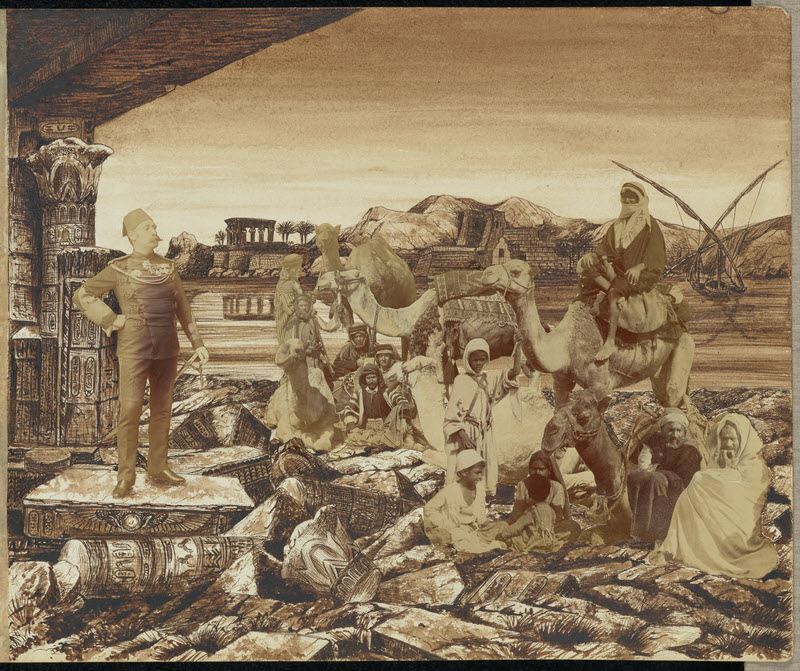Victorian photocollage albums were created in the second half of the nineteenth century almost exclusively by women of the British “Upper Ten Thousand”—the aristocracy and the landed gentry—England’s landowning class. This is a page from an album compiled by a woman whose identity remains unknown. In this scene, the artist strayed further afield from her familiar domestic realm to depict a composite setting in Khartoum, Sudan, a place she most likely never experienced herself. Relying on her imagination and news reports, she created a Eurocentric view of the 1885 fall of Khartoum.
The sole photographic figure on the left is Major-General Charles George Gordon (1833-1885), also known as “Chinese Gordon” for his British military role in suppressing the Taiping Rebellion, which lasted from 1850 to 1864. Later, in 1884, the British Government sent Gordon to Khartoum on a mission with little financial or personnel support to evacuate loyal soldiers and civilians amidst a revolt led by Muhammad Ahmad, a Nubian religious leader who had pronounced himself Mahdi, the “Rightly-Guided One” in Islamic tradition.
In this collage, Gordon faces twelve people and five camels—a group compiled from multiple photographs. There are several possible interpretations as to who these men, women, and children represent; perhaps they signify citizens of Khartoum whom the major-general intended to protect.
The compass in Gordon’s hand alludes to his engineering skills. He devised a plan to protect the city by digging a system of trenches to the south. He also placed a flotilla of gunboats along the banks of the Blue and White Nile rivers, which is drawn by hand in the background. Perhaps the collagist intended for the group of people to stand in for the Khartoumians who carried out the hard work.
After holding up against the Mahdi-led rebels for over a year, Khartoum fell and Gordon was killed. The twelve people he confronts may instead be substitutes for the rebels.
Made from the vantage point of a sitting room in London or in the British countryside, this image reinforces a British citizen’s view of the events that took place far away. In the process, it secures the social and political position of the upper-class white woman who compiled the album and of her family. Major-General Gordon was a popular figure with the British public and the legend of his dramatic death cemented his position as a hero for many. This scene provides an unexpected serious side to an album filled primarily with lighter aspects of upper-class British life.
Artistically, the collage is radical. In the 1920s or 1930s, a Dadaist such as Hannah Höch or a Surrealist such as Dora Maar would have envied this composition with its multiple perspectives and chaotic, dense montage of imagery.
Gordon is featured in one other collage in this album, situated in a much calmer environment, seated behind an office desk.
- Carolyn Peter, J. Paul Getty Museum, Department of Photographs
